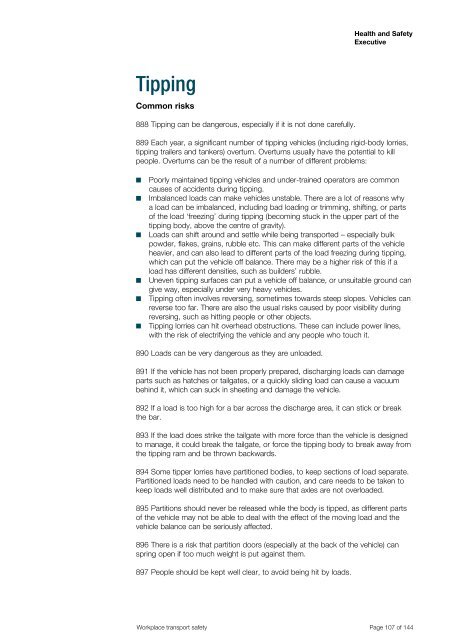Workplace transport safety An employers' guide - ARRI Lighting Rental
Workplace transport safety An employers' guide - ARRI Lighting Rental
Workplace transport safety An employers' guide - ARRI Lighting Rental
You also want an ePaper? Increase the reach of your titles
YUMPU automatically turns print PDFs into web optimized ePapers that Google loves.
Tipping<br />
Common risks<br />
888 Tipping can be dangerous, especially if it is not done carefully.<br />
Health and Safety<br />
Executive<br />
889 Each year, a significant number of tipping vehicles (including rigid-body lorries,<br />
tipping trailers and tankers) overturn. Overturns usually have the potential to kill<br />
people. Overturns can be the result of a number of different problems:<br />
n Poorly maintained tipping vehicles and under-trained operators are common<br />
causes of accidents during tipping.<br />
n Imbalanced loads can make vehicles unstable. There are a lot of reasons why<br />
a load can be imbalanced, including bad loading or trimming, shifting, or parts<br />
of the load ‘freezing’ during tipping (becoming stuck in the upper part of the<br />
tipping body, above the centre of gravity).<br />
n Loads can shift around and settle while being <strong>transport</strong>ed – especially bulk<br />
powder, flakes, grains, rubble etc. This can make different parts of the vehicle<br />
heavier, and can also lead to different parts of the load freezing during tipping,<br />
which can put the vehicle off balance. There may be a higher risk of this if a<br />
load has different densities, such as builders’ rubble.<br />
n Uneven tipping surfaces can put a vehicle off balance, or unsuitable ground can<br />
give way, especially under very heavy vehicles.<br />
n Tipping often involves reversing, sometimes towards steep slopes. Vehicles can<br />
reverse too far. There are also the usual risks caused by poor visibility during<br />
reversing, such as hitting people or other objects.<br />
n Tipping lorries can hit overhead obstructions. These can include power lines,<br />
with the risk of electrifying the vehicle and any people who touch it.<br />
890 Loads can be very dangerous as they are unloaded.<br />
891 If the vehicle has not been properly prepared, discharging loads can damage<br />
parts such as hatches or tailgates, or a quickly sliding load can cause a vacuum<br />
behind it, which can suck in sheeting and damage the vehicle.<br />
892 If a load is too high for a bar across the discharge area, it can stick or break<br />
the bar.<br />
893 If the load does strike the tailgate with more force than the vehicle is designed<br />
to manage, it could break the tailgate, or force the tipping body to break away from<br />
the tipping ram and be thrown backwards.<br />
894 Some tipper lorries have partitioned bodies, to keep sections of load separate.<br />
Partitioned loads need to be handled with caution, and care needs to be taken to<br />
keep loads well distributed and to make sure that axles are not overloaded.<br />
895 Partitions should never be released while the body is tipped, as different parts<br />
of the vehicle may not be able to deal with the effect of the moving load and the<br />
vehicle balance can be seriously affected.<br />
896 There is a risk that partition doors (especially at the back of the vehicle) can<br />
spring open if too much weight is put against them.<br />
897 People should be kept well clear, to avoid being hit by loads.<br />
<strong>Workplace</strong> <strong>transport</strong> <strong>safety</strong> Page 107 of 144
















